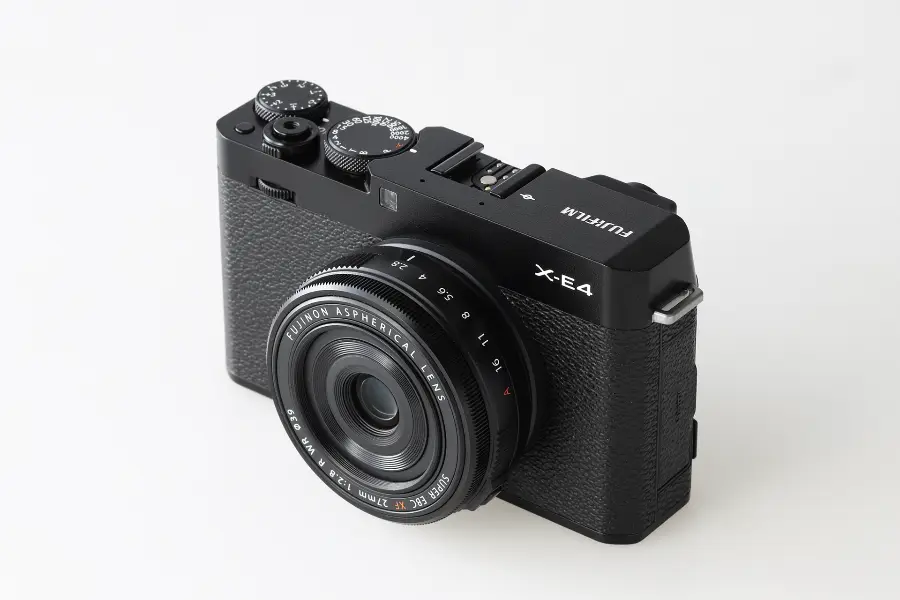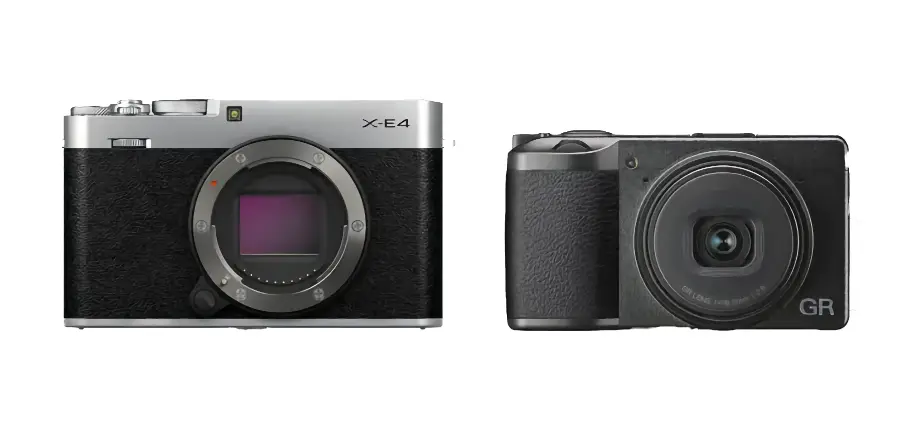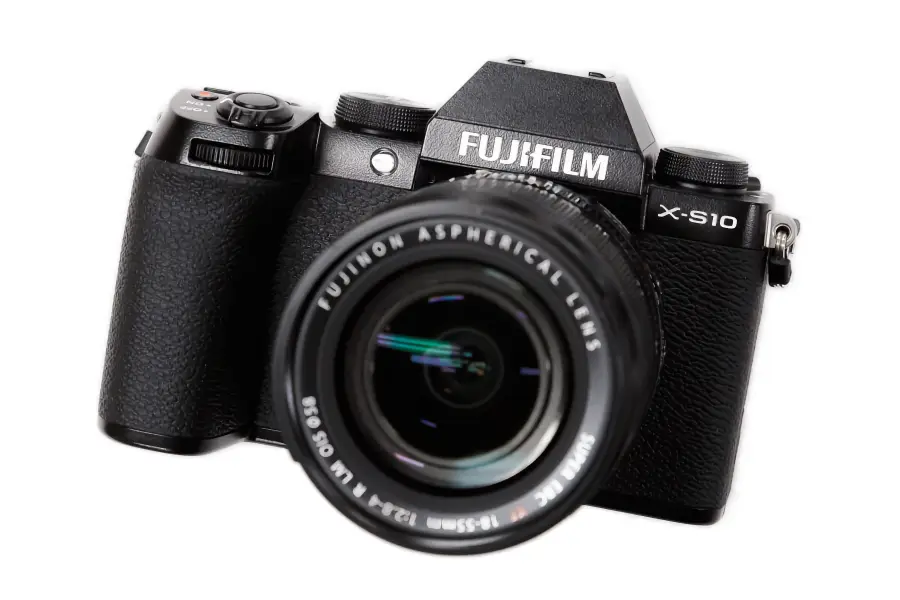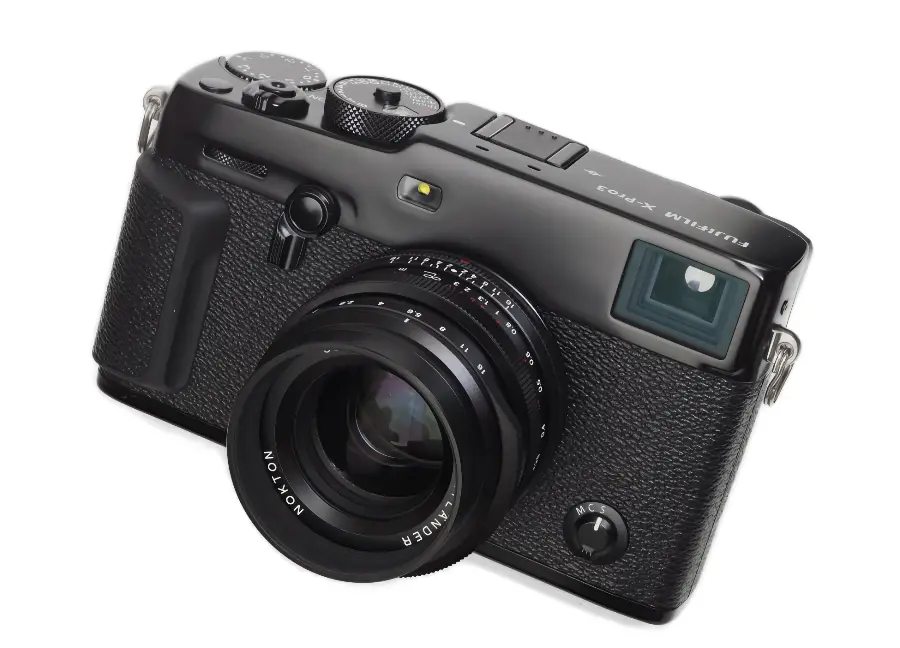
The Fujifilm X-E4 is a mirrorless camera that combines retro design with modern functionality. In this review, we’ll examine the X-E4’s key features, pros and cons, and share detailed insights based on six months of real-world usage.
Key Specifications

| Specification | Details |
|---|---|
| Sensor | 26.1MP X-Trans CMOS 4 (APS-C) |
| Processor | X-Processor 4 |
| ISO Range | 160-12800 (expandable to 80-51200) |
| Continuous Shooting | Up to 8fps (mechanical), 20fps (electronic) |
| Autofocus | 425-point phase-detection AF |
| Screen | 3-inch 180-degree tilt LCD (1,620K dots) |
| Viewfinder | 0.39-inch OLED EVF (2,360K dots) |
| Video | 4K/30p, 1080/240p |
| Weight | Approx. 364g (including battery and memory card) |
| Dimensions | 121.3 x 72.9 x 32.7 mm |
| Battery Life | Approx. 380 shots (CIPA rating) |
| Storage Media | SD/SDHC/SDXC cards (UHS-I supported) |
| Connectivity | Wi-Fi, Bluetooth |
🎨 Design & Build Quality
Retro-Inspired Compact Design

The Fujifilm X-E4’s greatest appeal is undoubtedly its design. The classic rangefinder-style exterior isn’t just aesthetically pleasing but also offers practical advantages.
- Size and Weight: With dimensions of 121.3 x 72.9 x 32.7 mm and weighing 364g, it offers excellent portability.
- Simple Exterior: Features a minimalist design that eliminates unnecessary elements.
- Desk Decor: The camera’s beautiful appearance makes it an attractive desk accessory even when not in use.
Grip and Operability

The X-E4’s extreme minimalist design results in some compromises in grip comfort. Some users opt to add separate grip accessories.
- Dial Operation: The top-mounted shutter speed and exposure compensation dials enable intuitive operation.
- Customization: Various function buttons can be configured to user preferences.
📸 Image Quality & Performance
X-Trans CMOS 4 Sensor

The X-E4 features the 26.1MP X-Trans CMOS 4 sensor, the same found in Fujifilm’s flagship models, delivering excellent image quality.
- Resolution: The 26.1MP resolution is sufficient for most photographic needs.
- Low-Light Performance: Supports a wide ISO range of 160-12800 with excellent noise control at high sensitivities.
Fujifilm’s Color Science

One of the greatest strengths of Fujifilm cameras is their superior JPEG quality and color reproduction.
- Film Simulation: Offers various film simulation modes for achieving desired color tones easily.
- JPEG Quality: Excellent JPEG output quality that often requires no additional post-processing.
Autofocus Performance

The X-E4 employs a 425-point phase-detection AF system.
- AF Speed: Shows significantly improved AF speed compared to previous models.
- Face/Eye Detection: Supports face and eye detection AF, useful for portrait photography.
🔍 Viewfinder & LCD
Electronic Viewfinder (EVF)

Features a 0.39-inch 2.36M-dot OLED EVF.
- Resolution: Provides crisp images with 2.36M-dot resolution.
- Eye Sensor: The somewhat sensitive eye sensor may require careful attention during use.
Tilt LCD Screen

Offers a 3-inch 1.62M-dot tilt LCD.
- Tilt Function: 180-degree tilt capability makes selfie shooting easy.
- Touch Operation: Supports touchscreen operation for intuitive control.
🎛️ Controls & User Experience
Intuitive Controls

The Fujifilm X-E4’s controls are streamlined to match its simple exterior design.
- Dial Operation: Top dials allow quick access to key settings.
- Q Menu: Quick menu provides fast access to frequently used settings.
User Experience

Based on six months of real-world usage:
- Increased Shooting Motivation: Beautiful design encourages more frequent camera use and photography opportunities.
- Improved Workflow: Excellent JPEG quality enables direct social media sharing without post-processing.
📽️ Video Features

The Fujifilm X-E4 supports 4K/30p video recording.
- Resolution Options: Offers various resolution and frame rate options including 4K/30p and 1080/240p.
- F-Log: Supports 10-bit 4:2:2 F-Log recording for professional video work.
📊 Competitor Comparison
vs Sony A6400

- Design: X-E4 offers a more classic and beautiful design.
- AF Performance: Sony A6400 provides superior AF performance.
- Color: Fujifilm’s color reproduction and film simulations are more appealing.
vs Fujifilm X-T30 II

- Size: X-E4 is more compact.
- Grip: X-T30 II provides a more comfortable grip.
- Features: Most core features are identical.
vs Ricoh GR III

- Sensor Size: Both use APS-C sensors, but X-E4 offers higher resolution.
- Lens Exchange: X-E4 supports interchangeable lenses while GR III has a fixed lens.
- Pocketability: GR III is smaller and lighter, offering better portability.
🔍 Lens Selection

Recommended lenses for the Fujifilm X-E4:
- XF 35mm f/2 R WR: Compact size and excellent image quality complement the X-E4 well.
- XF 23mm f/2 R WR: Ideal for wide-angle shooting and street photography.
- Voigtländer NOKTON 35mm f/1.2: Though manual focus, popular for its excellent rendering and unique character.
📸 Real User Experience & Tips

Additional tips and insights based on six months of real-world use:
- Consider Grip Accessories: Consider using grip accessories for comfortable extended use.
- Utilize Custom Settings: Assign frequently used settings to custom buttons for quick access.
- Eye Sensor Awareness: Due to sensitive eye sensor, consider manual EVF/LCD switching when needed.
📊 Pros and Cons Summary

Pros
- Beautiful retro design
- Compact and lightweight body
- Excellent image quality and color reproduction
- Various film simulation modes
- Intuitive controls
- Superior JPEG quality
Cons
- Potentially insufficient grip
- Limited shooting angles due to fixed LCD
- Sensitive eye sensor
- Relatively short battery life
🏁 Conclusion

The Fujifilm X-E4 is a perfect choice for photography enthusiasts who love retro design. With its compact size, excellent image quality, and intuitive controls, this camera is versatile enough for everything from everyday snapshots to travel photography and street photography.
Its outstanding JPEG quality and diverse film simulation modes are particularly advantageous, allowing satisfactory results without post-processing. However, some users might find the grip somewhat lacking and the fixed LCD limiting.

In conclusion, the Fujifilm X-E4 is highly recommended for users who prioritize design and image quality, and those seeking a compact camera. It’s particularly ideal for photographers who primarily shoot JPEG and enjoy film simulations.
One of the X-E4’s greatest charms is how its appearance alone increases shooting motivation and frequency. With this camera, your photographic journey will become more enjoyable and enriching.








